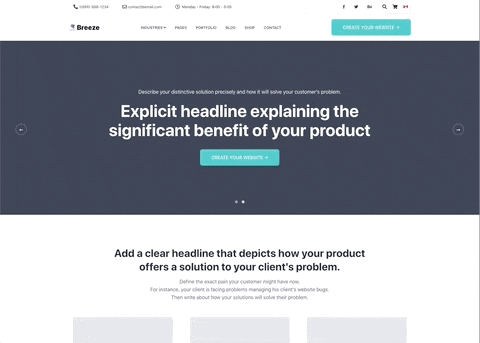When you think about landing pages, consider them as the front door to your online presence. They are specifically designed to capture a visitor’s attention and guide them toward a particular action, whether that’s signing up for a newsletter, downloading an eBook, or making a purchase. Unlike regular web pages that may serve multiple purposes, landing pages focus on a single goal.
This singular focus is what makes them so effective in converting visitors into leads or customers. You might wonder why landing pages are so crucial for your marketing strategy. The answer lies in their ability to streamline the user experience.
When someone clicks on an ad or a link, they expect to find relevant information that aligns with their interests. A well-crafted landing page meets those expectations, by providing targeted content that resonates with the visitor’s needs. By understanding the purpose of landing pages, you can create a more engaging experience that encourages users to take action.
Subscribe for more free tips and resources >
Key Takeaways
- A landing page is a stand-alone web page created specifically for a marketing or advertising campaign.
- An effective landing page design should be visually appealing, easy to navigate, and focused on a single call-to-action.
- Compelling call-to-actions should be clear, concise, and create a sense of urgency to encourage visitors to take the desired action.
- A/B testing involves creating two versions of a landing page to test which one performs better, and making data-driven decisions for optimization.
- Clear and concise messaging on a landing page helps to communicate the value proposition and benefits of the offer to visitors.
Design and Layout
A clean, uncluttered layout helps visitors focus on the key elements of your page. Use ample white space to separate different sections to make it easy for users to navigate through the content without feeling overwhelmed. Choose colors and fonts that align with your brand identity.
Crafting Compelling Call-to-Actions

A call-to-action (CTA) is arguably one of the most critical components of your landing page. It’s the element that prompts visitors to take the next step, whether that’s clicking a button or filling out a form. To craft compelling CTAs, you need to be clear and direct about what you want users to do. Use action-oriented language that creates a sense of urgency or excitement, such as “Get Started Now” or “Claim Your Free Trial Today.”
Placement is important. You want your CTA’s to be easily visible without being intrusive. Place your primary CTA above the fold, so it’s one of the first things users see when they land on your page. Use contrasting colors for your CTA buttons so that they stand out from the rest of the content, making it easier for visitors to identify where they should click next.
Implementing A/B Testing for Optimization
A/B testing is a powerful tool that allows you to compare two versions of your landing page to determine which one performs better. By making small changes—like altering the headline, adjusting the color of your CTA button, or modifying the layout—you can gather valuable data on what resonates best with your audience. This process helps you optimize your landing page and provides insights into user behavior and preferences. When conducting A/B tests, it’s important to focus on one variable at a time. This way, you can accurately assess which change had the most significant impact on conversion rates.
After running your tests, analyze the results carefully. Look for patterns in user engagement and conversion rates to inform future design decisions. Remember, optimization is an ongoing process; regularly testing and refining your landing page will help you stay aligned with your audience’s needs.
Utilizing Clear and Concise Messaging
The messaging on your landing page should be clear and concise, ensuring that visitors quickly understand what you’re offering and why it matters to them. Start with a strong headline that captures attention and communicates the main benefit of your offer. This is your chance to make a great first impression, so choose words that resonate.
Once you have their attention, use subheadings and bullet points to break down information into digestible chunks. This format makes it easier for visitors to scan the content and grasp key points. Avoid jargon or overly complex language; instead, aim for straightforward messaging that speaks directly to your audience’s needs and desires.
Leveraging Social Proof and Testimonials

Social proof is a powerful psychological phenomenon that can significantly influence decision-making. When potential customers see that others have had positive experiences with your product or service, they are more likely to trust you and take action themselves. Incorporating testimonials, reviews, or case studies on your landing page can help build credibility and encourage conversions.
To maximize the impact of social proof, choose testimonials that highlight specific benefits or results achieved through your offering. Including photos or names (with permission) can add authenticity and make the testimonials feel more relatable. Additionally, consider showcasing any awards or recognition your business has received to further reinforce trust and position yourself as an authority in your field.
Subscribe for more free tips and resources >
Optimizing for Mobile Responsiveness
Many users access websites through their mobile devices, making mobile responsiveness essential for any landing page. A responsive design ensures that your page looks great and functions well on various screen sizes, providing a seamless experience for all visitors. If your landing page isn’t optimized for mobile, you risk losing potential customers who may become frustrated with a poor user experience.
To optimize for mobile responsiveness, start by testing your landing page on different devices and screen sizes. Pay attention to how elements like images, text, and CTAs appear on smaller screens. You may need to adjust font sizes, or rearrange content to ensure everything is easily accessible and visually appealing on mobile devices.
Remember, a well-optimized mobile landing page can significantly enhance user engagement and boost conversion rates.
Analyzing and Monitoring Landing Page Performance
Once your landing page is live, analyze and monitor its performance regularly. Utilize analytics tools to track key metrics such as conversion rates, bounce rates, and user behavior on the page. This data will provide valuable insights into how well your landing page is performing, and where there may be opportunities for improvement.
Set specific goals for what you want to achieve with your landing page and use analytics to measure progress toward those goals. If you notice areas where performance is lacking—such as high bounce rates or low conversion rates—don’t hesitate to make adjustments based on the data you’ve collected. Continuous monitoring and analysis will help you refine your approach over time, ensuring that your landing page remains effective in driving conversions.
Conclusion
Creating an effective landing page involves understanding its purpose, designing it thoughtfully, crafting compelling CTAs, implementing A/B testing, utilizing clear messaging, leveraging social proof, optimizing for mobile responsiveness, and continuously analyzing performance. By focusing on these key elements, you can create a landing page that attracts visitors and converts them into loyal customers.
If you are looking to improve your landing page optimization, you may also be interested in learning about the importance of having a strong tech stack. A well-rounded tech stack can greatly enhance your website’s performance and user experience. Check out this article on what is a tech stack to gain a better understanding of how technology can impact your online presence.
Subscribe for free tips, tools and resources >
FAQs
What is landing page optimization?
Landing page optimization is the process of improving the elements on a website’s landing page to increase conversions. This can include improving the design, content, and user experience to encourage visitors to take a specific action, such as making a purchase or signing up for a newsletter.
Why is landing page optimization important?
Landing page optimization is important because it can significantly impact the success of a website. By improving the effectiveness of a landing page, businesses can increase their conversion rates, generate more leads, and ultimately drive more revenue.
What are some best practices for landing page optimization?
Some best practices for landing page optimization include having a clear and compelling call-to-action, using high-quality and relevant imagery, keeping the page load time fast, and ensuring the page is mobile-friendly. Additionally, A/B testing different elements of the landing page can help identify what resonates best with visitors.
How can I measure the success of my landing page optimization efforts?
The success of landing page optimization efforts can be measured using key performance indicators (KPIs) such as conversion rate, bounce rate, time on page, and click-through rate. By tracking these metrics, businesses can assess the impact of their optimization efforts and make data-driven decisions for further improvements.
What are some common mistakes to avoid in landing page optimization?
Common mistakes to avoid in landing page optimization include having a cluttered or confusing layout, using vague or uninspiring language, not optimizing for mobile devices, and not testing different variations of the page. It’s important to continuously monitor and refine the landing page to avoid these pitfalls.



